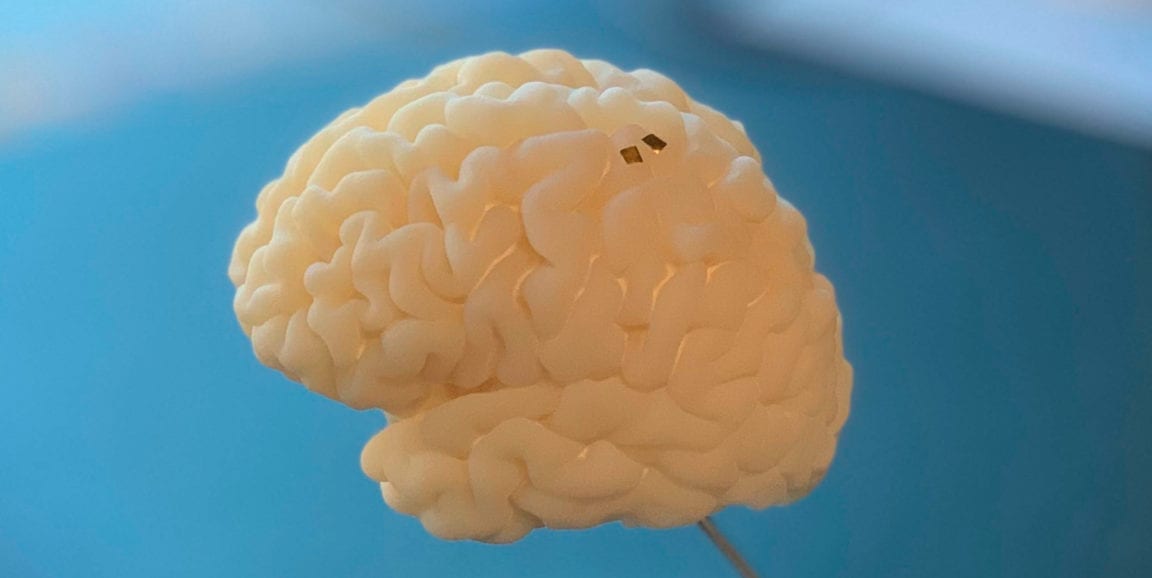
Photo of a current neural implant, that uses wires to transmit information and receive power, by Sergey Stavisky
Stanford researchers have been working for years to advance a technology that could one day help people with paralysis regain use of their limbs, and enable amputees to use their thoughts to control prostheses and interact with computers.
The team has been focusing on improving a brain-computer interface, a device implanted beneath the skull on the surface of a patient’s brain. This implant connects the human nervous system to an electronic device that might, for instance, help restore some motor control to a person with a spinal cord injury, or someone with a neurological condition like amyotrophic lateral sclerosis, also called Lou Gehrig’s disease.
The current generation of these devices record enormous amounts of neural activity, then transmit these brain signals through wires to a computer. But when researchers have tried to create wireless brain-computer interfaces to do this, it took so much power to transmit the data that the devices would generate too much heat to be safe for the patient.
The way to a wireless device
Now, a team led by electrical engineers and neuroscientists Krishna Shenoy, PhD, and Boris Murmann, PhD, and neurosurgeon and neuroscientist Jaimie Henderson, MD, have shown how it would be possible to create a wireless device, capable of gathering and transmitting accurate neural signals, but using a tenth of the power required by current wire-enabled systems. These wireless devices would look more natural than the wired models and give patients freer range of motion.
Graduate student Nir Even-Chen and postdoctoral fellow Dante Muratore, PhD, describe the team’s approach in a Nature Biomedical Engineering paper.
The team’s neuroscientists identified the specific neural signals needed to control a prosthetic device, such as a robotic arm or a computer cursor. The team’s electrical engineers then designed the circuitry that would enable a future, wireless brain-computer interface to process and transmit these these carefully identified and isolated signals, using less power and thus making it safe to implant the device on the surface of the brain.
Testing the idea
To test their idea, the researchers collected neuronal data from three nonhuman primates and one human participant in a (BrainGate) clinical trial.
As the subjects performed movement tasks, such as positioning a cursor on a computer screen, the researchers took measurements. The findings validated their hypothesis that a wireless interface could accurately control an individual’s motion by recording a subset of action-specific brain signals, rather than acting like the wired device and collecting brain signals in bulk.
The next step will be to build an implant based on this new approach and proceed through a series of tests toward the ultimate goal.
The Latest Updates from Bing News & Google News
Go deeper with Bing News on:
Electronic prostheses
- Prosthetic Heart Valves, Part I: Identification and Potential Complications
Geriatrics and Aging. 2006;9(10):691-696. The following sections present information about the most commonly implanted (contemporary) mechanical and bioprosthetic heart valves. The intent is to ...
- External Breast Prostheses: Misinformation and False Beliefs
This article discusses common myths associated with the use of external breast prostheses and the impact this misinformation may have on the quality of life of women after mastectomy. A review of ...
- 'You want it to look perfect because it’s someone’s eye': Ocularists are small group and it's even tougher to get into the industry
While facilities to treat people with prosthetic eyes are limited, it’s even tougher for someone to get into the industry. Unless they’re willing to commit a lot of time to the craft.
- Founder of charity that provides prosthetics to amputees raises $500,000 ahead of marathon
BOSTON - The founder of a charity that's raised half a million dollars to provide prosthetic legs to fellow amputees will be taking part in Monday's marathon. Steve Chamberland has made it his ...
- Marine who lost arm in Afghanistan makes his own superhero-like prosthetic — now he can lift up to 400 lbs
An ex-Marine and father of one who lost an arm in Afghanistan got his power back — and then some — after receiving a custom-made, superhero-like prosthetic replacement that can lift up to 400 ...
Go deeper with Google Headlines on:
Electronic prostheses
[google_news title=”” keyword=”electronic prostheses” num_posts=”5″ blurb_length=”0″ show_thumb=”left”]
Go deeper with Bing News on:
Thought controlled electronic prostheses
- Best Smart Locks of 2024
Instead, many smart locks have keypads for PINs and/or electronic keys ... “Smart locks can add an invaluable level of peace of mind,” says Misha Kollontai, CR’s test engineer for door ...
- MIT Technology Review
L. Ron Hubbard, Operation Midnight Climax, and stochastic terrorism—the race for mind control changed America forever. On an early spring day in 1959, Edward Hunter testified before a US Senate ...
- With neurotech, control over our minds is less absolute than we think
He warned that writing undermines memory—that it is nothing but a reminder of some previous thought. Compared to ... People may not be able to completely control what gets into their heads ...
- Astroturf | Control the monkey mind
It, thus, becomes incumbent upon a being to first control one’s monkey-mind, for the indwelling virtues to play out unhindered. And that can be achieved following the two-stage meditation process.
- Brain-Computer Interface Enables Mind-Control Gaming
The concept of brain-computer interfaces is simple: use technology to help “read” a person’s mind and execute commands ... as the initial neurophysiological control features of an expert ...
Go deeper with Google Headlines on:
Thought controlled electronic prostheses
[google_news title=”” keyword=”thought controlled electronic prostheses” num_posts=”5″ blurb_length=”0″ show_thumb=”left”]










